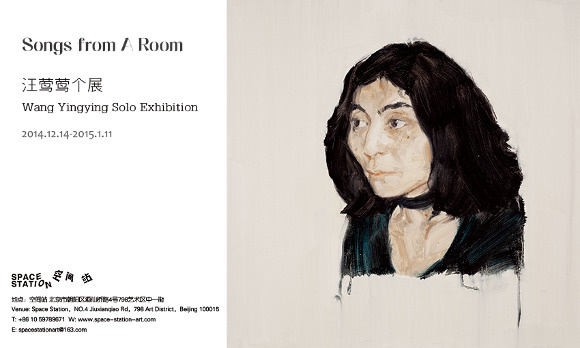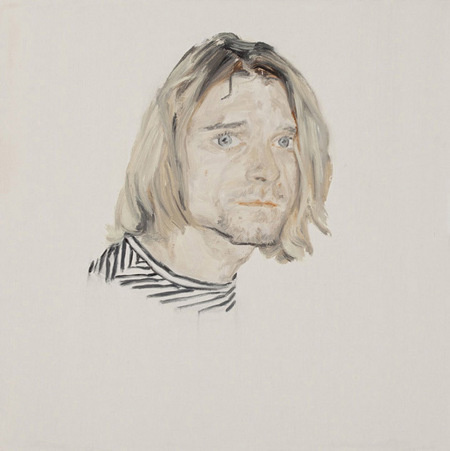
Wang Yingying’s first solo exhibition “Songs from a Room” will be on display at Space Station from Dec. 14th to Jan. 11st, 2014. Wang is a young teacher of oil painting faculty in Nanjing Art Academy, and we can clearly see the integration of classical portrait style and modern popular culture in her, an integration with no paradox or conflict, but with a succinct, pure and relaxed temperament. Wang says she is afraid of literary description, which is easily replaced by words. She is more interested in constructing her own painting language, for it offers bigger space for the painter himself or herself to control. Therefore, she does not mind using pictures from pop culture as materials and does not dwell too much on the careful composition of picture (The Portrait series, 2013-2014), does not have to be a front (The Back series, 2013-2014), and even for her familiar friends, she would create some distance by using defamiliarization (The In Nanjing series, 2011-2014).
“Defamiliarization” or “Alienation effect” (Verfremdungs Effekt) is put forward by the German playwright Bertolt Brecht. The concept can be traced to the same origin with the “ostranenie” put forward by Viktor Shklovsky of the Russian formalism. Verfremdung in Deutsch is a very expressive word, which includes multi-layered meanings like alienating, distancing, defamiliarizing, and dissimilating. “Defamiliarization” later becomes one of the key concepts of Russian formalism theory, which considers that the aesthetic of art lies in the freshness brought by amazing and unfamiliar things. Shklovsky in his Art as Technique says, the purpose of art is to make people feel the things, not just simple know the things. The technique of art is to defamilarize the object, making the form difficult by increasing the difficulty of feeling and the length of time, because the feeling process itself is the purpose of aesthetics, and the artist should try to expand it. “Defamiliarization” is not only for the sake of novelty, but arousing and exciting people from their apathy and numbness towards life.

Wang Yingying, Kurt Cobain, 2013; Oil on canvas, 50x50cm
“Songs from a Room” comes from the name of Leonard Cohen’s 1969 LP, for the exhibition attempts to use the name to describe a way of inspecting from a distance the things we are familiar with. Defamiliarized painting language resembles the sound of a song that comes from a room, both familiar but distanced because of the retranslation through certain medium. This is a kind of re-understanding of the sense organ, a kind of re-perceiving, trying to create a new aesthetics of re-understanding and re-perceiving. Wang has been limiting herself within a pure, narrow, and two-dimensional form, which seems to have become her doctrine on creation. She likes to leave more space outside the painting, viewing the work as an invitation to various kinds of extended meanings, and as a summoning of fresh perception, illustrating that an indirectly open painting can bring more possibilities of multi-perspective interpretations.

Wang Yingying, Marion Cotillard, 2013; Oil on canvas, 50x50cm
This exhibition mainly consists of her works from 2013 to 2014. It has the Back and several other earlier series, which are about the friends around her, pieces of common life, familiar corners, her rough, ambiguous, and ash gray paintings. Sometimes we can even see the repetitive daubing trace her flowing brush strokes have left on the canvas when it is still wet. She places the object within a safe and communicative distance, with some emotions in relax, yet we can also feel her restrained and prudent attitude towards the expression of emotions. She constantly simplifies and refines the painting language in order to make the painting pure and unified. She never cares the supposed relation and distance between the artist and the figure portrayed in the painting, yet almost all the figures she draws have shown some intimate relationship with her. In The Portrait series, those celebrities do not conceal their inner loneliness and melancholy in front of her, enabling us to learn the more private inner world and some peculiar, paranoid behaviors behind the limelight. The titles of her works are named after the names of the figures portrayed, increasing the privacy of the works. The application of transparent paints not only shows the power of the brush stroke, but also strengthens the character’s inner world, building up a sensitive and ambiguous atmosphere. This simple and direct sense of distance is exactly the charm of Wang’s works.
About the exhibition
Duration: 14 December, 2014 - 11 January, 2015
Venue: Space Station
Courtesy of the artist and Space Station.




























